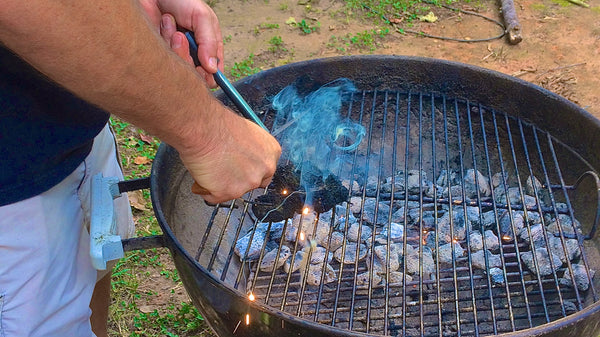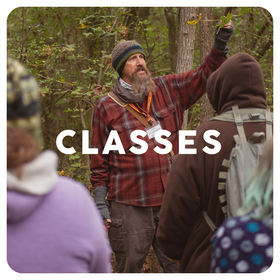
Bushcraft Gold in Your Own Backyard
Doing the stuff of self-reliance takes time, resources, tools, and want to. More important than any of these is ACTION! With only 24 hours in a day, you can't always trek to your personal space in the woods to practice wilderness living skills. Hectic schedules and time constraints eat away at your availability.
Your family needs quality time... and no, staring at the TV or computer screen doesn't count. No better way to hang out with your loved ones than to introduce them to outdoor self-reliance skills in a controlled setting. Your adventures await one step over your doorsill - no wilderness required!
It would be great if we all had a picturesque wilderness for a backyard. That's not likely. Driving hours to reach one is not practical for busy people.
Fire Pits and BBQ Grills!
Making fire is a critical skill many of us take for granted. In ideal conditions, fire may be easy. Just flick your Bic and, poof, you have flames. It's wise to practice several ways to achieve a sustainable fire.

You can practice your fire making skills with the available resources out back. No wood? No problem. Walk your neighborhood, wagon in tow, collecting dead wood conveniently stacked at the edge of neighbor's yards.
Practice making fire using different methods: friction (bow drill or hand drill), heat (fresnel lens, lighter, matches, etc.), and sparks (ferro rod, flint and steel). You'll need your homemade char material for the flint and steel.

Make a fire from one stick only. If you're neighborhood allows open fires in a fire pit, consider building or buying one. If not, practice inside a charcoal or gas grill. If grills aren't allowed, call the moving van! Build fires directly on the grill grate or use a board or other flat object as a support.
What's for Dinner?
After building a fire, why not use it to practice cooking over an open flame. Since you're in the backyard and conveyance is not an issue, break out that cast iron Dutch oven granny passed down to you. Once your fire burns down a bit, suspend the pot over a bed of coals with a bushcraft tripod. Experiment with cooking methods other than stabbing a tube steak on the end of a stick.
Tied in Knots
Do you remember how to tie that nifty knot you saw on YouTube? Probably not. Find two trees in the yard and practice tying out your tarp and hammock. Repetition is the mother of all learning.
Basic knots should become second-hand. You won't need to know 41 knots to enjoy a camping trip. Knowing a few simple knots will save you time and cordage.
The knots I use most while bushcrafting are the timber hitch, trucker's hitch, blood knot, bowline, clove hitch, and prussic loop. Learn knots with a specific purpose and tie them repeatedly until you're able to do so even in the dark.
READ MORE: Knife Review: Helle Didi Galgalu
Sharp Skills
The cutting tool is fundamental for bushcraft. Safe use of knives, saws, and axes should be learned before heading to the big boy woods. The backyard is the perfect classroom.

Wielding sharp tools has risks. You never really know your cutting tool personally until it bites you. Accidents happen to even the most skilled bushcrafter. Practicing in a controlled setting like your backyard builds confidence and skills for times when your life may one day depend upon sharp stuff. Plus, first aid is close by.
Sharp Skill 1: Make a feather stick for your backyard fire. Bracing your knife against your knee with the cutting edge facing away from your body, pull a piece of wood towards your body to curl shavings on the stick. You can also place the stick on another wooden surface and slice curls using the full length of the blade.

Sharp Skill 2: To baton your knife is a personal choice. This skill is useful when a camp ax is not available. This method can produce pencil lead size, pencil size, thumb size, and larger fuel from logs. I prefer batoning for the one stick challenge and when creating bow drill sets. More precision in woodcraft can be achieved by practicing your preferred method.
Sharp Skill 3: Notches add stability when joining and lashing woodcraft items. They're also essential for the hearth board on your bow drill fire set. Carving pot hooks is another way to learn knife skills while making functional tools for the backyard fire pit.
Doing the Stuff of self-reliance should start in your backyard. 17th and 18th century woodsmen forged their skills close to home. Owning these essential skills was necessary to survive the wilderness treks with minimal gear. That's the essence of bushcraft - dependence on skills more so than the latest shiny object and technological gadget.
What happens when technology fails? Hopefully your skills will get you through. Your journey to self-reliance starts in your own backyard!





